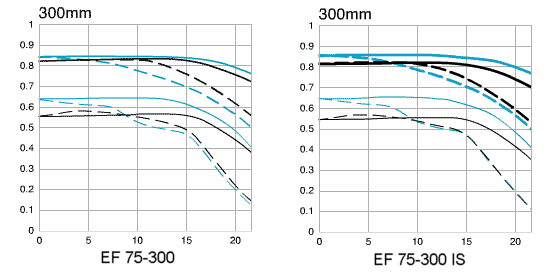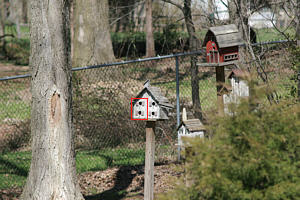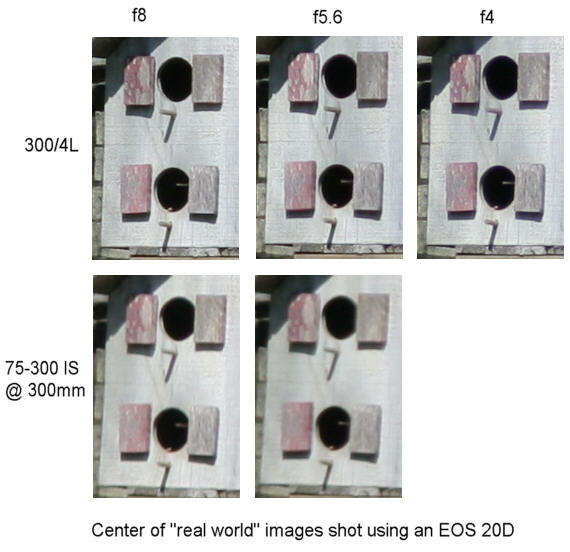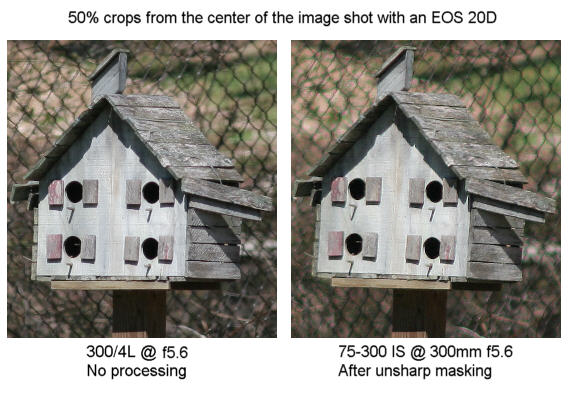
|
Canon EF 300/4L USM vs. EF 75-300/4-5.6 IS USM Lens ReviewI see a lot of "users" commenting in on-line forums that the Canon EF 75-300 lenses are very soft, especially at 300mm, sometimes commenting that the lens is "unusably soft". While I agree that they aren't the sharpest lenses, I often wonder just what these users are seeing. I wonder if some of them are just repeating "conventional wisdom", which in this case may not be all that wise, or if the results they are seeing is more a consequence of how they use the lens than the lens' intrinsic quality (or lack of it). So, having both the EF300/4L USM and the EF75-300/4-5.6 IS USM available, I decided to do some testing. I didn't have a non-IS version available for testing, but a number of years ago I did test the IS lens against a non-IS version and I really didn't see a significant difference. The Canon MTF plots for the IS and non-IS versions of this lens seem to support the conclusion that their performance is essentially the same
Test ChartsThese images are 100% crops from images of a USAF 1951 resolution test chart, shot using the 75-300/4-5.6 IS USM at 200mm and 300mm, and a 300/4L USM. For the shots at 200mm the camera and lens were moved closer to the target to maintain the image size. The camera and lens were supported on a sturdy tripod and head (Bogen 3051 with Arca Swiss B1). Autofocus was used. The first set of crops are from the center of the image.
From these images it seems the difference between these lenses isn't huge (though see the "real world" images later for more on this). It's quite clear that the 75-300 IS at 300mm improves as it's stopped down. Contrast and sharpness are higher at f8 than f5.6. At f5.6 and f8 the 300/4L USM is sharper and has higher contrast. The second set of crops are taken from the corner of the EOS 20D frame using the same lenses.
It's obvious here that the 300/4L shows less chromatic aberration than the 75-300 IS. The 300/4L also has higher contrast. Real WorldResolution charts are one thing, but the results of such tests don't always easily translate to "real world" performance. For a real world test I took shots of the scene shown below at various apertures with both lenses. The area outlined in red is shown as a 100% crop in the next set of comparative images
It's fairly clear here that the 300/4L outperforms the 75-300 IS. In fact the 300/4L is better at f4 than the 75-300IS is at 300mm and f8. The difference on real world targets is certainly more obvious than it was on the test charts. So is the 75-300 "unusably soft"? Well, all is not lost. Digital processing come to the rescue as shown below:
Here we see the results of some fairly aggressive unsharp masking on the image from the 75-300 IS. As you can see, the 50% crops now look very similar indeed. Some people might regard this as "cheating", but the results speak for themselves I think. On my monitor (17", 1280x1024 resolution), the crops above represent sections of a 20"x30" print. ConclusionDespite lots of negative comments on the Canon 75-300 lenses, I think many of them may stem from users who simply don't know how to use a 300mm lens. This could be because the 75-300 lenses are seen as "starter" lenses for beginners, and so tend to be bought and used by less experienced photographers. They may be shooting handheld at shutter speeds too low for sharp images, they may be shooting moving subjects or they may not be optimizing their images with a good image editor. I don't know. I do know that the EF 75-300/4-5.6 IS USM is a decent lens. It's not as good as a 300/4L, it's not as sharp and it focuses significantly slower, but when used properly and with the help of a little digital magic, it's a lens capable of yielding pretty sharp images. This especially appplies when shooting digital if, when at 300mm, you stop down a stop, optimize the image in PhotoShop and don't try to make huge prints. I've had one in my camera bag for 6 or 7 years now and I use it quite a lot. It's not the only lens I have and it's not the lens I reach for first when I want the highest possible quality at 300mm, but it's a lens that has proven both very useful and capable of making images of surprisingly good quality when used within its limitations. LinksWhere to buyAs usual, I'll suggest looking at Amazon. If you buy directly from them they offer free shipping and a 30-day return policy.
© Copyright Bob Atkins All Rights Reserved |
|





